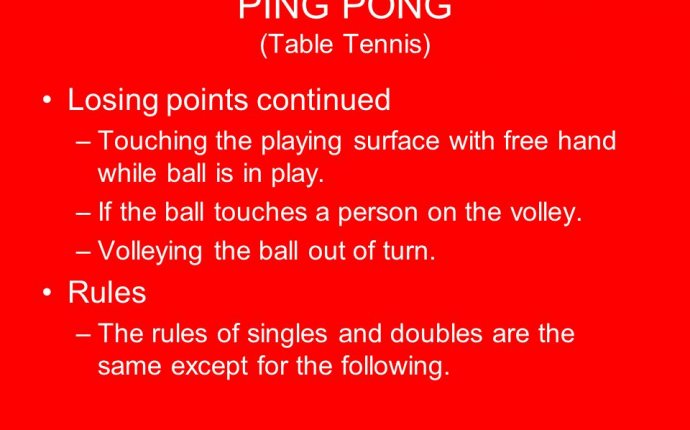
Rules of table tennis singles
 I’ve heard a number of ridiculous rules brought about by recreational players that are just silly. I’ll try to dispel some of these myths and give a short-list of the essential rules you need to know when serving. If you can follow the rules outlined here, this should prevent 99% of the conflicts that often arise from not following rules.
I’ve heard a number of ridiculous rules brought about by recreational players that are just silly. I’ll try to dispel some of these myths and give a short-list of the essential rules you need to know when serving. If you can follow the rules outlined here, this should prevent 99% of the conflicts that often arise from not following rules.
The Myths
- Myth #1: In a singles match, you have to serve diagonally (like in doubles).
In Doubles, you’re required to serve from the right half of your side to the opposite side in the opponent’s half (diagonally). But this rule doesn’t apply at all in Singles. You’re free to serve anywhere, diagonally or straight, from any location. - Myth #2: When you serve, the ball cannot fall off the side of the table. It must bounce twice or fall off the far end.
When you serve, the ball is allowed to go anywhere, whether double-bouncing on the table, going off the end, or going off the sides. There’s no restriction on location as long as it hits both sides of the table. Update: Apparently this myth comes from the rules regarding players in wheelchairs but has been mistakenly applied to standing players. It’s there to prevent serves from going out of reach while seated. - Myth #3: After you toss the ball, you can catch the ball and re-serve.
This isn’t normal tennis. Once you toss the ball, the ball is in play and you cannot decide that you don’t like your toss and re-do it. Just make the best of it and complete the serve!
Service Rules
Here are the rules you need to know:
- You must toss the ball upward at least 16cm or 6 inches.
A lot of players players don’t get the required height from their toss and will either hit the ball right out of their hand or do a quick drop-and-hit. This creates an unfair advantage because it takes more skill and focus to control a ball on a higher toss than a drop-and-hit where the ball is practically stationary in the air. - Your toss must be “near vertically upward”, not heavily sideways or backward. It’s common to see players throwing the ball backward (away from the table) to help generate more underspin, but try to avoid this practice. Your toss should be mainly vertical, with very little horizontal movement in any direction. It’s somewhat problematic that the rule is vague as it doesn’t give a definition of how straight your toss must be. Can you toss it at a 45° angle? Is that vertical enough? Referees will use their own discretion, but try not to dance on the fine line. My own tosses are generally about 15° from the vertical.
- You must strike the ball as it is on its way down. (Rule 2.06.02)
You can’t hit the ball as it’s on the rise from your toss, it must have started falling before you make contact. It doesn’t have to drop all the way down to the point where you tossed it, but it has to be falling. So if you tossed it 20cm high, you can hit it when it drops even 1cm from the top of the toss. - The entire serve (from toss to first contact with racket) must start behind the end line and
Some players will either start the toss with the ball already inside the table, or will strike the ball while the ball is over the table, which is illegal. Also, the ball height must always be above the table surface, so you can’t wind up your super-high toss by starting the toss below the table surface. - You cannot hide the ball with your body or arm during serve.rules, you could leave your free arm in front to obscure the view of the receiver so they can’t see what serve you’re doing, but that has changed. Now you must remove your free arm (and body) so that the receiver has full view of the ball throughout the entire serve process.
If you can just follow these rules, you should be able to avoid any fisticuffs and expletives at your next tournament. If you’re very thorough you can have a look at the ITTF rule book, but it’s a pretty dry read, so you would do fine by just following this post. Or just check out the service rules.
And if you want to improve your serves, check out the Serves section in the Coach Wiki, or the Serve Training Videos section.









